Written by: Messari, Matt Kreiser, Tehsin Amlani
Compiled by: 1912212.eth, Foresight News
Important content
Metaplex is a digital asset protocol for Solana and the Solana Virtual Machine (SVM). It provides tools and standards for creating, managing, and scaling digital assets, including NFTs, homogenous tokens, RWAs, game assets, DePIN assets, and more. More than 800 million assets have been minted in 9 million wallets through Metaplex.
Metaplex’s digital asset standards have become the foundation of the Solana ecosystem, providing standardized architecture and behavior that ensures interoperability and liquidity across applications.
Last December, Metaplex launched public beta access for the Metaplex Aura Network, a data network designed for Solana and the Solana Virtual Machine (SVM).
Metaplex has developed nearly every major innovation for digital assets on Solana, including compressed NFTs, on-chain copyright enforcement, core plugins (programmable assets), and Aura, the first data network optimized for digital assets. Metaplex’s integration with major Solana applications (such as Phantom, Magic Eden, Tensor, and Pump.fun) as well as emerging applications drives adoption and expanded functionality of digital assets in the network ecosystem.
introduce
The rapid rise of digital assets has driven the need for more efficient and scalable solutions. This demand presents significant challenges, particularly with regard to the high costs associated with on-chain storage and transaction processing on various networks. This is where Metaplex comes in, supporting all types of assets on Solana and the Solana Virtual Machine (SVM). With its range of innovative solutions and developer experience, it has become a recognized digital asset protocol and critical infrastructure on Solana and SVM. Metaplex provides standards for tokens and NFTs on Solana, similar to ERC-20 or ERC-721, and it accounts for more than 99% of NFT issuance on Solana and the vast majority of homogenous token issuance on the network.
As a fully vertically integrated digital asset protocol, Metaplex is one of the most widely used protocols on Solana. Its on-chain library drives a large amount of on-chain activity, and its developer tools enable developers and applications to read data related to digital assets. In addition, Metaplex's Aura is the first data network optimized for digital assets on Solana and SVM, giving Metaplex's on-chain programs new capabilities, such as allowing asset data to flow in and out of Solana account space as needed, thereby supporting composability or security.
Together, these solutions provide an end-to-end developer experience that Solana’s competitors like Ethereum lack, where separate projects dominate NFT issuance and management, blockchain indexing, and data availability, respectively, while Metaplex offers a comprehensive suite that covers all of these capabilities.
Aura also brings new functionality to the Metaplex token MPLX, as MPLX tokens are required to run an Aura node and pay for data access. New features and innovations like Aura will continue to be added as the protocol aims to maintain and further expand its dominance in digital asset issuance and management on Solana and the SVM, while launching new services like indexing and data availability.
The Metaplex Protocol is governed by the Metaplex DAO, which is comprised of MPLX token holders, and managed by the Metaplex Foundation, a non-profit organization dedicated to supporting and growing the Metaplex ecosystem.
background
Metaplex was created within Solana Labs in June 2021 and co-founded by Stephen Hess, former head of product at Solana Labs. In August 2021, it was donated to the Metaplex Foundation, a non-profit organization dedicated to the long-term development of the Metaplex ecosystem.
In June 2021, Metaplex was founded within Solana Labs, co-founded by former Solana Labs Product Lead Stephen Hess. In August 2021, Metaplex was transferred to the Metaplex Foundation, a non-profit organization dedicated to the long-term development of the Metaplex ecosystem. Other important events in the protocol’s history include:
January 2022: Metaplex received $46 million in strategic financing from investors including Multicoin Capital, Solana Ventures, Animoca Brands, Cultur3 Capital and Blue Pool Capital.
July 2022: Metaplex launches its Digital Asset Standard (DAS) and DAS API for interacting with digital assets on Solana.
September 2022: MPLX token launches with an airdrop period for eligible community members and early protocol builders.
November 2022: Metaplex Foundation launches compressed NFT program (Bubblegum).
January 2023: Launch of programmable NFTs with copyright protection enforcement.
April 2024: The protocol’s latest NFT standard, Core, is launched. Core uses a single account design to reduce minting costs and improve Solana network load. In addition, several well-known crypto funds including Pantera Capital and ParaFi Capital acquire MPLX tokens formerly held by FTX Legacy.
September 2024: Metaplex launches Aura, a data network that scales Solana and the Solana Virtual Machine (SVM).
The Metaplex protocol is governed by the Metaplex DAO, which is composed of MPLX token holders and managed by the Metaplex Foundation. Half of all protocol fees are used to buy back MPLX tokens, which are then contributed to the DAO's treasury. The DAO may allocate tokens from the treasury to ecosystem development incentives at its discretion.
technology
The Metaplex protocol consists of five main components:
Digital Asset Standard (DAS)
Metaplex Programming Library (MPL)
Metaplex Developer Platform
Metaplex Aura Network
MPLX Token
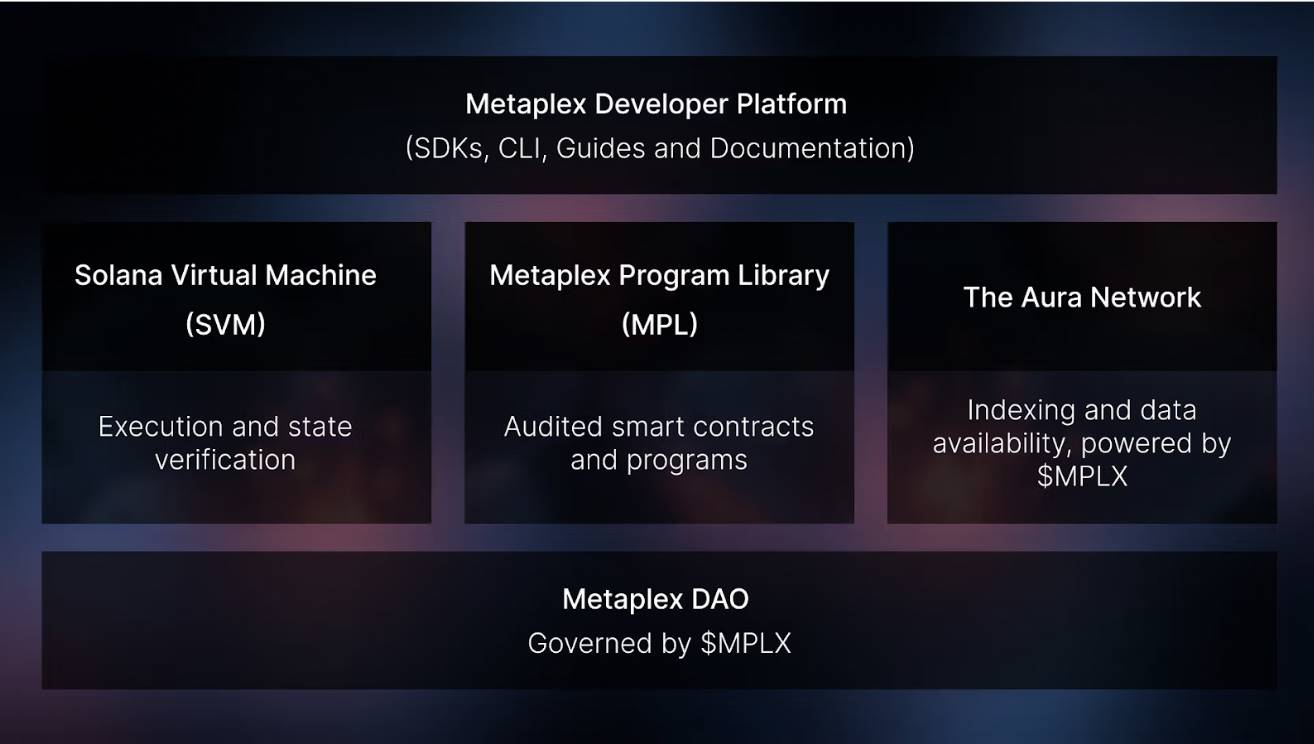
Digital Asset Standard (DAS)
Similar to how the Ethereum ecosystem relies on the ERC-20, ERC-721, and ERC-1155 standards, the Solana ecosystem relies on the Metaplex Digital Asset Standard (DAS). Therefore, almost all digital assets on Solana are Metaplex digital assets.
DAS is a standardized framework that ensures consistency and interoperability between different digital assets and applications on Solana. DAS establishes the necessary architecture, behavior, and system design for various types of digital assets. These asset types include but are not limited to NFTs, compressed NFTs, homogenous tokens (including meme coins), RWAs, DePIN assets, game assets, digital art, and token extensions.
Metaplex’s DAS provides a significant competitive advantage over competing ecosystems by offering a dedicated protocol and community focused on continued innovation at the standard layer. This provides developers, creators, and collectors with the assurance of continued improvement and support.
DAS Key Features
DAS provides a structured and composable framework for defining components of digital assets, such as images, configurable copyright percentages, and collections, facilitating their integration and interoperability within the Solana ecosystem. DAS’s flexible digital asset behaviors, such as metadata mutability, transfer semantics, and rights management, ensure that assets can be easily updated, transferred, or refactored as needed.
DAS supports both on-chain and off-chain storage options, providing diversity in unit economics and scalability. On-chain storage ensures immutability and security, while off-chain storage provides a cost-effective and scalable solution for large amounts of metadata. The off-chain indexing and query standards established through the reference implementation make data retrieval more efficient and have performance advantages, thereby improving the user experience.
In addition, DAS remains compatible with Ethereum standards through a two-way bridge on the Wormhole network, ensuring interoperability between Metaplex digital assets and Ethereum assets. This compatibility enables digital assets to achieve wider coverage and higher liquidity, which benefits the entire Solana ecosystem.
Metaplex Programming Library (MPL)
The Metaplex Library (MPL) is the second component of the Metaplex protocol. It provides an on-chain implementation of DAS on Solana, enabling applications to create and manage digital assets.
MPL provides developers with on-chain tools designed to build decentralized applications that leverage digital assets, such as marketplaces and launchpads, DeFi applications, games, DePIN, RWA platforms, on-chain subscriptions, ticketing solutions, and more. It includes products covering the entire digital asset supply chain, from creation, initial sales to utility. All components of MPL are open source and available on GitHub. Here are some key Solana programs in MPL:
Metaplex Core
Metaplex Core is the latest standard launched by Metaplex for Solana NFTs. Metaplex Core introduces a clearer and more efficient digital asset specification than previous standards, improving cost efficiency and network performance. Core operates with a very small computational unit (CU) footprint, allowing each block to include more transactions. Specifically, Core requires 17k CUs to mint NFTs, while other standards require 205k CUs. Core provides several key features:
Single account design
A key feature of Metaplex Core is its single account design. Unlike traditional fungible token standards, such as the Solana Program Library (SPL) token or token extensions, which rely on multiple accounts, Metaplex Core focuses on the needs of NFTs. This single account design not only tracks owners, but also encapsulates all necessary data within a single Solana account without relying on token programs. This architecture significantly reduces minting costs and improves the overall load of the Solana network. For example, the cost of minting an NFT using Metaplex Core is estimated to be 0.0029 SOL, while using the token metadata standard requires 0.022 SOL.
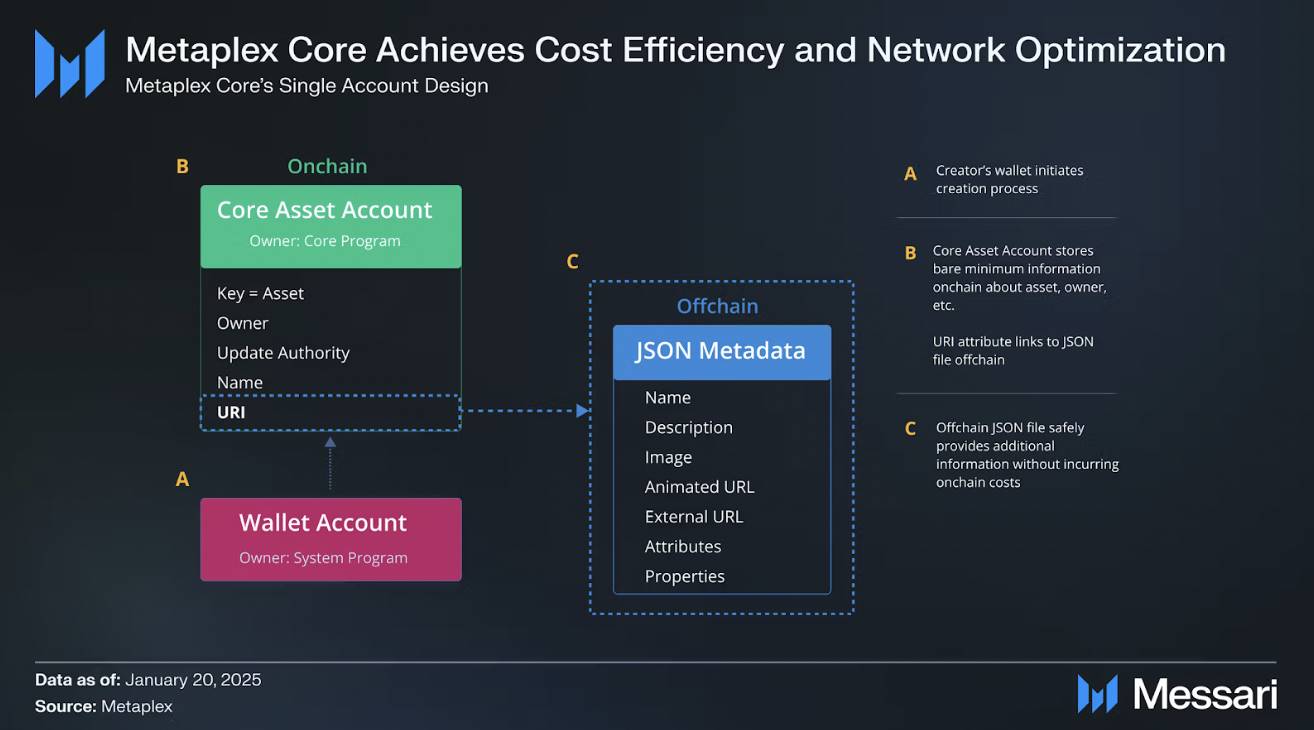
Metaplex Core uses a hybrid data storage approach that combines on-chain and off-chain data. Core assets and collection accounts contain the necessary on-chain data, as well as URI attributes pointing to off-chain JSON files. This off-chain file provides additional information without incurring the high cost of storing large amounts of on-chain data.
Flexible plugin system
Metaplex Core includes a plugin system that makes Core assets more dynamic, efficient, and flexible for developers. This flexible plugin system allows developers to customize the behavior and functionality of digital assets by hooking into any asset lifecycle events, such as creation, transfer, and destruction. Plugins can provide a wide range of utility functions, from built-in staking and asset-based points systems, to advanced features like delegated permissions and on-chain properties, which are automatically indexed by the Metaplex DAS API. Developers can also write their own external plugins to extend Core by using external data or controls to add behavior to assets. Unlike standard plugins that only use asset data, external plugins can interact with data from other accounts or programs, making Core assets more customizable.
Enhanced collection management
Metaplex Core allows assets to be grouped and managed at the collection level. This capability makes possible collection-level operations, such as freezing all assets in a collection or changing all royalty details in a transaction. In addition, Core collections can have unique properties and plugins that override default settings, providing a greater level of customization and control. For example, a developer can add a royalty plugin to a collection so that all assets share the same copyright settings, or override these settings for individual assets as needed.
Native Metaplex DAS API support
Core assets are automatically indexed and made available to application developers via the Metaplex DAS API, a common interface for all Solana NFTs. Additionally, all plugins are automatically indexed, including plugins that allow for the use of generic on-chain data, such as the Properties plugin or the AppData plugin. Notable historical examples are that users of the Phantom and Backpack wallets were able to view their Core assets before the developers of those applications had completed full integration with Core.
Bubblegum
Metaplex’s Bubblegum program supports compressed NFTs (cNFTs) on Solana. The scalability of NFTs has been limited by the linear growth of leasing costs on the Solana chain (0.012 SOL per Token Metadata NFT and 0.0014 SOL per Core asset). Bubblegum solves this challenge by significantly reducing the cost of NFT on-chain storage, enabling the technology to be more widely used.
For example, the cost of minting 1 billion NFTs would be 12 million SOL, making large-scale NFT applications economically unfeasible. In contrast, the cost of minting 1 billion cNFTs through direct transactions is only 5,000 SOL. This cost can be further reduced by 99% through batch minting supported by Aura (Metaplex's data network) (currently in development).
Bubblegum achieves scalability and cost-efficiency through the use of Merkle trees. This approach ensures that data remains verifiable while not taking up too much storage space, thereby reducing costs. Through these strategies, Bubblegum makes large-scale NFT applications more feasible and practical than traditional methods.

The Bubblegum program achieves the efficiency of the Merkle tree by strategically splitting on-chain and off-chain data storage. The core idea is to store only necessary data on-chain while keeping most of the data off-chain, but the off-chain data can still be verified through the Merkle root.
Only the Merkle root and necessary metadata are stored on-chain. These on-chain data provide the necessary integrity checks, ensuring that any off-chain data can be verified by the immutable Merkle root stored on-chain.
The detailed data and metadata of NFTs are stored off-chain, allowing for wider scalability. This data remains secure and verifiable, as any changes to the off-chain data will result in changes to the Merkle root, which is stored on-chain. This association of on-chain and off-chain data ensures that the off-chain data remains consistent with the on-chain state while being tamper-proof.
Although Bubblegum does not store NFT data directly in accounts, it still supports various cNFT operations:
Minting: cNFTs can be minted without or with a collection.
Transfers: cNFTs can be transferred between accounts.
Update: The metadata of a cNFT can be updated.
Destruction: cNFT can be destroyed and removed from the Merkle tree.
Unpacking: cNFTs can be unpacked into regular NFTs, making them interoperable with existing smart contracts, but will be subject to on-chain account rental fees.
Delegation: Ownership and management of cNFTs can be delegated.
Verification: Collections and creators of cNFTs can be verified or de-verified.
Practical application and efficiency
Minting cNFTs involves creating a collection and setting Merkle tree parameters. Metaplex's Bubblegum SDK and Umi tools simplify this process, allowing developers to mint and manage NFTs at scale. Once minted, NFTs are stored in a compressed format, greatly reducing storage costs while maintaining the same metadata schema as uncompressed NFTs.
Bubblegum achieves a delicate balance between cost-effectiveness and security through state compression and parallel Merkle tree data management methods. By keeping most of the data off-chain and only storing necessary proofs on-chain, the system significantly reduces storage costs. At the same time, the use of cryptographic hashing ensures that the data remains secure and verifiable. This combination makes NFT management both scalable and cost-effective, making it an attractive solution for developers and creators.
Token Metadata
The Token Metadata Program is a foundational program built on top of the Solana Token Program that is used to attach additional data to both fungible and non-fungible tokens. Metaplex’s Token Metadata Program does this by deriving from the address of the minting account using programmatically derived addresses (PDAs). On Solana, the minting account is responsible for storing global information about the token, while the token account stores the relationship between the wallet and the minting account.
While minting accounts on Solana contain some data properties (such as current supply), they do not provide the ability to inject standardized data that can be understood by applications. Therefore, the token metadata program provides a metadata account that is attached to the minting account via the PDA. Each metadata account contains a "URI" attribute that points to an off-chain JSON file that provides additional data that is not subject to on-chain storage fees. Notably, this JSON file can be configured to be immutable after the initial configuration, which is particularly attractive to NFT developers. Therefore, for NFTs, the metadata account provides the data of the NFT that makes it a useful digital asset (i.e., describes its unique characteristics).
Another account specifically provided for NFTs is the master version account, which is another PDA derived from the minting account. When this account is created, the token metadata program transfers the minting and freezing permissions to this account instead of invalidating them. Therefore, the master version account serves as proof of the non-homogeneity of the minting account. It is worth noting that the master version account can also enable the minting of one or more copies of the NFT. The homogeneity status of a token is tracked in the token standard properties in the metadata account.
Prior to 2024, NFTs were the largest use case for the Token Metadata (TM) program. However, since then, the main use of the TM program has come from fungible tokens. Semi-fungible tokens (also known as "fungible assets") can also be implemented through the TM program. Semi-fungible tokens have a supply greater than 1 and have typical NFT properties such as images and arrays of properties in JSON metadata.
Additionally, it is worth noting that because the Token Metadata Program is built on top of the Solana Token Program, it cannot enforce any rules related to the tokens it is attached to. Therefore, programmable use cases like secondary market sales or transfer restrictions cannot be enforced. However, Metaplex has developed Programmable NFTs as a solution to this problem. Programmable NFTs are a new opt-in token standard that always keeps the underlying token accounts frozen so that no operations (such as transfers, locks, or destruction) can be completed without authorization from the Token Metadata Program. This allows creators to define operation-specific authorization rules (rule sets) and create and update these rule sets through Metaplex's Token Auth Rules metaprogramming tool.
Candy Machine (V3) and Core Candy Machine
Candy Machine (V3) is Metaplex’s program for fairly minting and distributing NFT collections on Solana, while Core Candy Machine provides the same functionality but for the issuance of Core assets.
Candy Machine supports fair distribution of NFTs by allowing creators to configure various launch parameters, such as verification processes, minting limits, start and end dates. It helps creators efficiently handle large-scale NFT issuance by supporting sequential or random minting of NFTs. In addition, the program provides extensive customization options to define the properties and metadata management of NFTs, ensuring that each NFT issuance can be customized to specific needs.
The lifecycle of a Candy Machine involves multiple stages. First, the creator configures the Candy Machine, with settings including the seller fee base point, the symbol for the minted NFT, the maximum edition supply, mutability options, and a list of creators and their respective royalty shares. Projects are then loaded into the Candy Machine, each of which is defined with a name and a URI pointing to off-chain JSON metadata. Once the configuration is complete and all prerequisites are met, users can begin minting NFTs. Some users may need to complete additional verification steps, such as solving a captcha or providing a Merkle proof, before they can begin minting. Once all NFTs have been minted, the Candy Machine can be deleted to free up on-chain storage space and recover rental fees.
Candy Machine has been an important part of the Solana NFT ecosystem since its launch. Not only have most of the top series (such as DeGods, Claynosaurz, SMB Gen3, etc.) been released through Candy Machine V3, but most of the launch platforms on Solana also use Candy Machine or its derivatives (for example, Magic Eden uses a derivative). Programs like Candy Machine and its derivatives simplify the asset creation process and drive transaction volume through Metaplex standards (such as Token Metadata and Core). In addition, Metaplex’s decision to make its utilities (such as Candy Machine) free of charge is a key value proposition for developers to choose Metaplex over competitors.
Metaplex Developer Platform
The Metaplex Developer Platform is a core component for effectively leveraging DAS and MPL, and is designed to facilitate the development of applications based on Solana by providing a comprehensive set of tools, software development kits (SDKs), and reference interfaces. Metaplex's existing programs and developer tools provide customers with a convenient way to integrate new Metaplex features. An example is the Aura network, which can be accessed through an SDK that is compatible with all the same frameworks and tools in the Metaplex developer ecosystem. The Metaplex Developer Platform includes the following key tools:
Umi
Umi is a modular framework for building and using JavaScript clients for Solana applications. It features a zero-dependency library that defines core interfaces as well as default implementations and bundles for developers to use.
Sugar
Sugar is a command line tool for interacting with and managing the entire life cycle of a Candy Machine. Its main advantages include a configuration file that contains all Candy Machine settings, and a multi-threaded system that speeds up the computational process of uploading media/metadata files and deploying Candy Machines.
DAS API
The DAS API provides a unified interface for interacting with digital assets on Solana, supporting standard (Token Metadata), compressed (Bubblegum), and Core assets. The DAS API is defined as a method for implementing asset data provision, most of which is indexed through the Metaplex digital asset RPC infrastructure. This approach aims to balance scalability and cost-effectiveness, making it easier for developers to manage and interact with a large number of digital assets. However, relying on off-chain data storage means relying on external RPC providers, which may affect reliability and consistency.
Metaplex Aura Network
Aura is Metaplex's optimized data network for Solana and the Solana Virtual Machine (SVM), secured by the MPLX token. Aura provides developers with efficient on-chain data access, including optimized indexing and querying of digital asset data, which is critical for building decentralized applications that can compete with centralized alternatives. With the launch of Aura, Metaplex provides a complete framework for developers to build applications on Solana: using the Metaplex Library (MPL), data can be written to the chain, and fees are paid using SOL, while with Metaplex Aura, developers can use MPLX to read this data in a decentralized and high-performance manner.
Aura first went live on the Solana mainnet and devnet in September 2024, followed by beta access to developers via a Google Forms application in November 2024, and a public beta in December 2024. Aura’s Eclipse Ethereum Layer-2 also launched in beta in November 2024, followed by a public beta in December 2024.
The Aura network is run by Aura nodes, which index both compressed and uncompressed states while providing critical data availability for compressed states. Aura has three main features:
Read Solana and SVM data: Aura provides developers with decentralized on-chain data reading permissions, and the fees are paid using MPLX.
Managing Compressed and Uncompressed States: Aura implements the Digital Asset Standard (DAS) API, providing indexing capabilities for any digital asset on Solana and the Solana Virtual Machine (SVM). In addition, in the future, developers and applications will be able to transition assets between SVM account spaces and different levels of state compression as needed.
Batch Minting NFTs: Batch minting is generated via an offline JSON object/file, and transactions are indexed by the Aura node. This feature is currently under development.
Aura introduces the term "elastic state" to describe the network's ability to transition assets between SVM account space and different levels of state compression as needed. Elastic state management supports Rollup minting transactions to create millions of assets to compressed state with 99% fewer transaction batches, and Aura nodes provide data availability (DA) to manage state transitions.
Aura is currently accessible directly through the public gateway and has been integrated into the Metaplex SDK and developer tools, providing developers with a complete digital asset creation and management solution. Alternatively, project owners can choose to run nodes directly to access the network.
The Metaplex Foundation's Aura repository is open source and the global developer community can contribute code to it. In addition, more than 25 projects, including top NFT markets, infrastructure providers, game developers, and SVM L2s, participated in the launch of Aura and provided feedback to improve and optimize the network.
MPLX Token Token Economics and Governance
MPLX Token
The MPLX token was launched in September 2022 as the governance token of the Metaplex protocol, rewarding community members and early protocol builders, and incentivizing protocol activity through airdrops. In November 2024, the launch of the Aura network provided additional uses for MPLX. The MPLX token is not only a requirement for operating an Aura node, but can also be used as a payment method to access the Aura network. In addition, half of the Metaplex protocol fees are used to repurchase MPLX tokens, which will then be contributed to the Metaplex DAO treasury.
Governance Rights
MPLX token holders have voting rights and are able to participate in key decision-making processes regarding:
Protocol Development and Roadmap: Determine the future direction and improvements of the protocol, as well as the utility of MPLX.
Treasury Fund Allocation: Vote on how to allocate funds in the treasury.
Protocol Ownership, Upgrades, and Deployment: Decisions concerning ownership, upgrades, and new deployments of protocols.
Respond to urgent and unexpected issues: Provide solutions to unexpected technical or compliance issues.
MPLX Grant Proposal
The Metaplex DAO Treasury contains MPLX tokens, which can be used to incentivize the growth of the Metaplex ecosystem. Contributors to the Metaplex ecosystem can submit funding proposals to the DAO to apply for MPLX or other available assets to promote the adoption of the Metaplex protocol and further integration of MPLX functionality. It is worth noting that all MPLX tokens funded through the DAO will be locked for one year. The funding proposal process is as follows:
Proposals: Anyone holding at least 200 MPLX can submit a funding proposal, and proposers must also complete KYC verification.
Preliminary review: The Metaplex Foundation conducts a preliminary review of proposals, requests additional information, and screens out "junk proposals" or proposals that violate relevant laws and regulations.
Community Feedback and Voting Period: Proposals that pass the Foundation's initial review will be published on the Metaplex Foundation's GitHub and will be put to vote. Each MPLX token equals one vote. Proposals must receive at least 66% support and the total number of votes must exceed the valid voting threshold (i.e. 1 million votes, or 0.10% of the total token supply).
Execution: If approved, the DAO Committee will release MPLX to the grant beneficiaries via direct transfer or smart contract.
Metaplex Improvement Proposal (MIP)
MIP is a process for proposing changes to the protocol (i.e. the Metaplex library). The MIP process is as follows:
Proposals: Anyone who holds at least 1,000 MPLX and pays a 10 USDC spam proposal waiver fee can submit a MIP. It is worth noting that the Metaplex Foundation will refund USDC for "proposals submitted in good faith."
Community feedback and preliminary review: The community provides feedback on the Metaplex Foundation's MIP discussion forum. During this period, the Metaplex Foundation has the right to screen out junk proposals, proposals that lack necessary details, and those that violate hard requirements, such as breaking backward compatibility, compromising security, or not complying with relevant laws and regulations.
Implementation Assignment: If a proposal passes, the Metaplex Foundation decides whether the proposal will be implemented by the Foundation or the community.
Voting Period: If the Foundation chooses to conduct a vote, the MIP voting period will be initiated. Each MPLX token equals one vote. The proposal must receive at least 66% support and the total number of votes must exceed the voting threshold specified by the Foundation.
MIP Implementation: If passed, the Metaplex Foundation will publish a development timeline stating the timeline for the approved proposal to be implemented by the Foundation. If implemented by the community, the Metaplex Foundation will request bids and select the winning bidder.
In addition, the Metaplex Foundation can make changes to the Metaplex library at its discretion, as long as these changes do not violate the hard requirements of the Metaplex library. Finally, the Metaplex Foundation can decide to terminate the MIP process at any time if the proposal conflicts with relevant laws or regulations.
Aura
On the Aura Network, the MPLX token has two main uses:
Node Operation: As of now, the Metaplex Foundation has released limited documentation on how MPLX can be used to operate a node on the Aura network. Both Metaplex’s developer documentation and the original blog post announcing Aura mention that “Aura nodes are secured by MPLX tokens.”
Payment: Metaplex offers a free tier for API testing and early project development, but access to the Aura network on a larger scale still requires payment in MPLX tokens. Under the pay-as-you-go model, each request has a specified price, and there are two unlimited plans available at 500 MPLX and 1,500 MPLX per month.
Buyback mechanism
Half of the Metaplex protocol's fees are used to buy back MPLX tokens and contribute them to the Metaplex DAO treasury. Specifically, "50% of the Metaplex protocol's fees from the previous month and historical fees" will be used to buy back MPLX each month. For example, in December 2024, Metaplex used 12,000 SOL to buy back MPLX, 50% of which came from November's protocol fees (7816 SOL) and the rest from historical fees (4,184 SOL). The DAO can also choose to distribute tokens from the treasury to incentivize the growth of the Metaplex ecosystem. From June to October 2024, Metaplex used 10,000 SOL per month for buybacks, and 12,000 SOL in November and December 2024, and January 2025, respectively. To date, the repurchase volume is approximately 44.47 million MPLX (4.45% of the total supply), with the largest repurchase volume in January 2025 reaching 9.2 million MPLX (0.92% of the total supply).
Earn Rewards
Approved by the Metaplex DAO, MPLX tokens are used to reward community members and incentivize activity. In December 2024, the Metaplex DAO approved Metaplex Earn Season 1, which will allocate 1 million MPLX (about 0.10% of the total supply) to reward liquidity providers who provide MPLX liquidity on major DEXs on Solana. The program begins in January 2025, and unused MPLX tokens will be returned to the DAO treasury after the program ends. Since the launch of the program, MPLX's on-chain liquidity has grown threefold to $7.7 million.
MPLX Token Distribution
The total supply of MPLX tokens is 1 billion, which will be fully unlocked on September 19, 2024, and its distribution is as follows:
(You can continue to provide specific distribution details here, such as the distribution ratio of the team, investors, community, ecosystem, etc.)
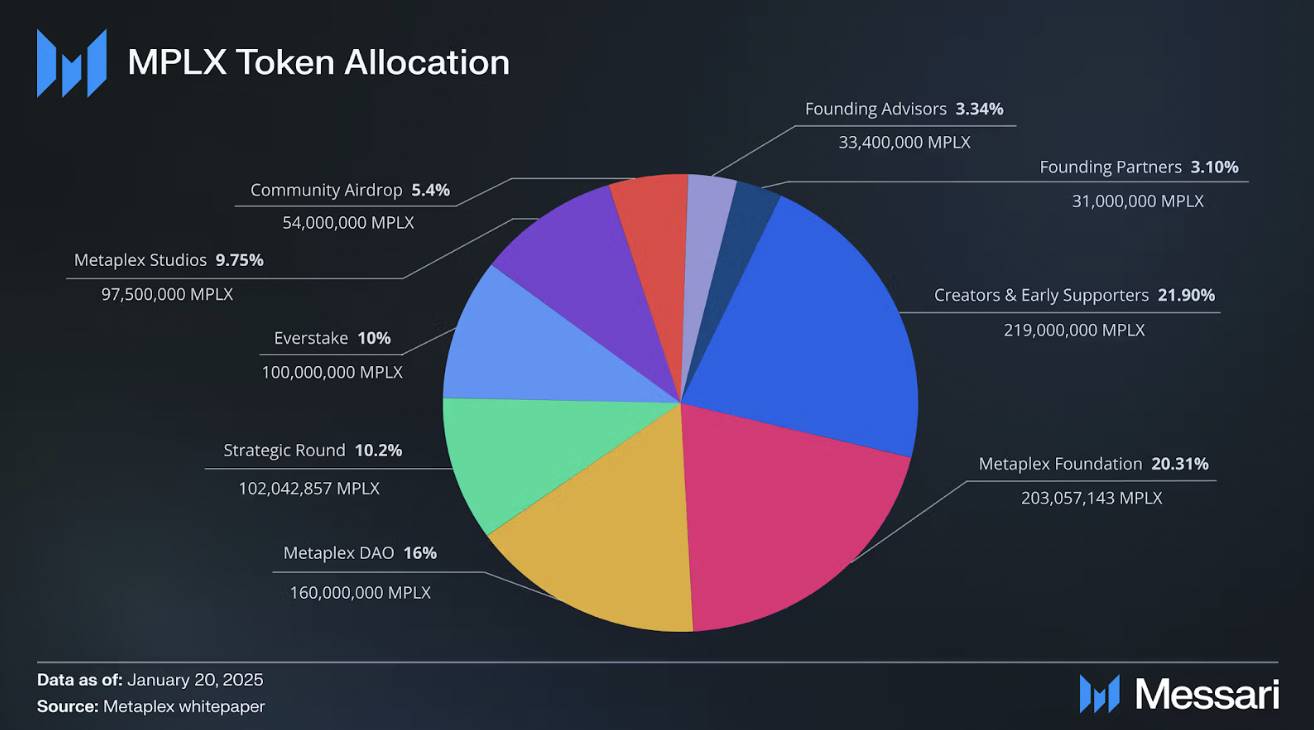
Creators and early supporters — 219 million MPLX (21.90%)
These tokens were allocated to key early backers and contributors who purchased tokens in the initial funding round and played an important role in the development of the ecosystem.
Each participant will receive 50% of the tokens one year after the first airdrop (September 19, 2022), and the remaining 50% of the tokens will be distributed in monthly installments for 12 months.
Metaplex Foundation — 203 million MPLX (20.31%)
The Metaplex Foundation is a non-profit organization established to promote research, development, and promotion of the Metaplex ecosystem.
These tokens are allocated to the Metaplex Foundation to reward and support the Metaplex community and drive the development, security, governance, and management of the Metaplex protocol and DAO.
These tokens are not subject to lock-up and can be used immediately.
Metaplex DAO — 160 million MPLX (16.00%)
These tokens are used by the Metaplex DAO for protocol changes, ecosystem funding, and strategic initiatives.
Tokens held by the DAO are governed by Metaplex and can be distributed over time through community proposals.
These tokens are not subject to lock-up restrictions.
Strategic Round — 102 million MPLX (10.20%)
The allocation was announced in January 2022 and is distributed to strategic capital providers and well-known figures in pop culture, entertainment, sports, etc., who have the role of promoting Metaplex and NFTs.
The unlocking schedule is the same as the distribution to creators and early backers, with a one-year cliff period followed by monthly distributions over the next year.
Everstake — 100 million MPLX (10.00%)
Everstake is a development company and Solana staking service provider, serving as one of the founding development teams of the Metaplex Foundation.
The tokens have a two-year cliff period, followed by a linear distribution for one year.
Metaplex Studios — 97.5 million MPLX (9.75%)
Metaplex Studios is the core development team serving the Metaplex Foundation, focusing on the development of MPL and DAS, including protocol development, development tools, commercial partnerships, community support and application development.
The tokens will have a one-year cliff period, followed by a linear distribution for two years.
Community Airdrop — 54 million MPLX (5.40%)
On April 29, 2022, the Metaplex Foundation provided Genesis Developer NFTs to developers who contributed to the Metaplex protocol and distributed 800,000 MPLX tokens to Genesis Developer NFT holders (Developer Airdrop).
Additionally, the Creator Airdrop allocated 13.2 million tokens to creators who launched NFT projects using the Metaplex library.
Additionally, 40 million MPLX tokens were given to heavy minters of Metaplex or early adopters of NFTs (collectors airdrop).
Airdropped tokens are not subject to lock-up restrictions and can be used immediately.
Founding Advisors — 33.4 million MPLX (3.34%)
The founding advisors have contributed to the promotion of Metaplex among creators and developers in the Web3 space.
These tokens have a one-year cliff lockup period, followed by a linear distribution for one year, and a one-year lockup period after the initial airdrop.
Founding Partners — 31 million MPLX (3.10%)
The Founding Partners are early supporters and partners of the Metaplex protocol, launching some of the earliest NFT stores and continuing to provide input on new features for libraries, NFT standards, and developer tools.
These tokens have a one-year cliff lockup period, followed by a linear distribution for one year, and a one-year lockup period after the initial airdrop.
Protocol Activity
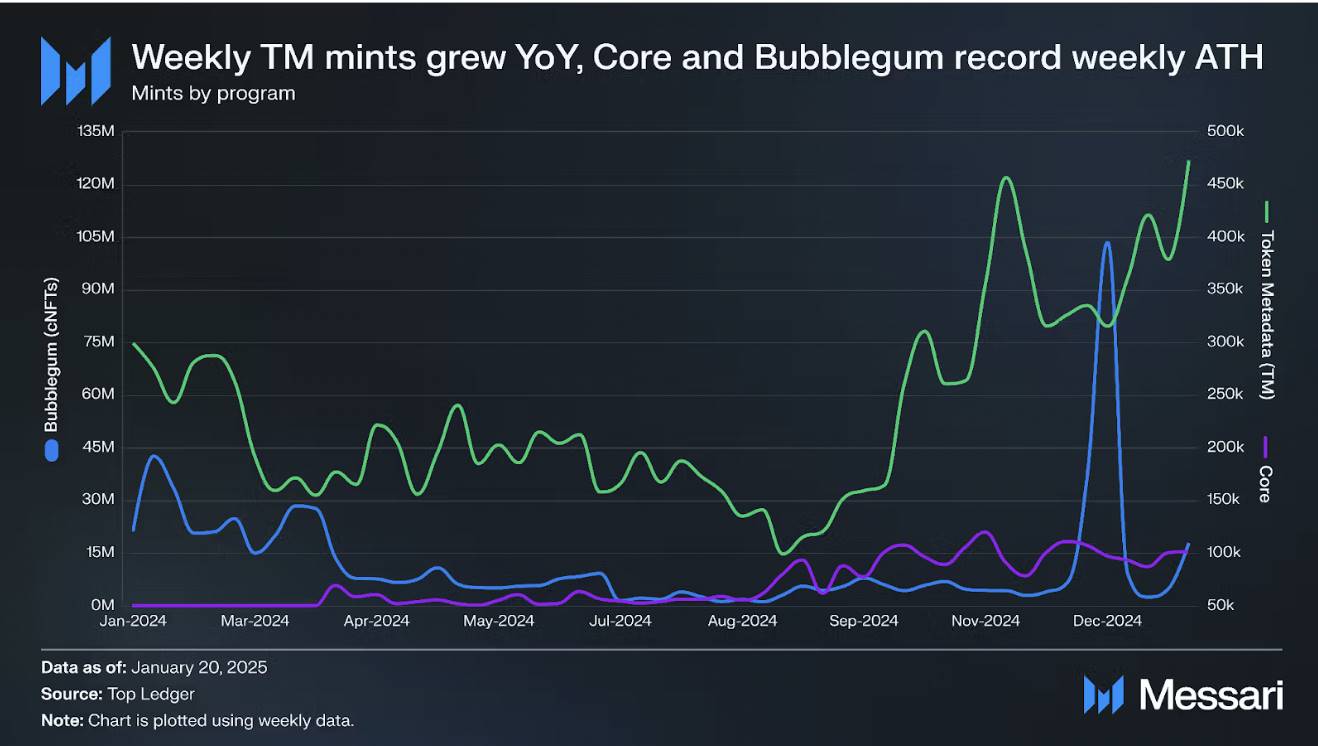
In 2024, weekly minting from the Token Metadata program increased by 58% year-over-year, from 300,000 to 473,000, a new 52-week high. Similarly, weekly minting from the Core program, launched in March 2024, also increased significantly in September 2024, from 50,000 to 20,000 coins per week to 50,000 to 120,000 coins per week, and peaked at 121,000 coins in the week of November 11, 2024. Weekly minting from the Bubblegum program, launched in 2023, also hit a new all-time high of 103.5 million coins in 2024, more than 20 times higher than the previous record in 2023.
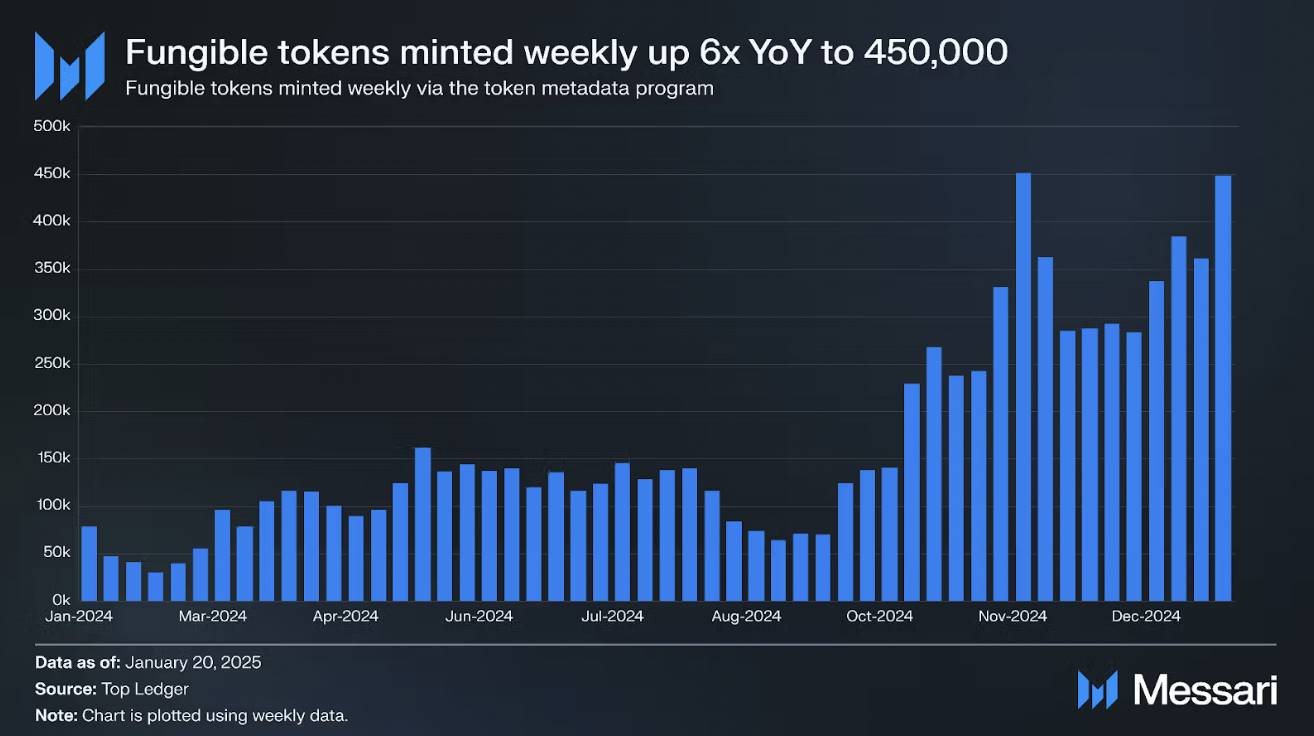
The number of weekly fungible tokens minted through the Token Metadata program has increased six-fold year-over-year, from 78,000 to 450,000, reflecting the rising trend of memecoin and AI token activity. Token launch platforms like Pump.fun and Meteora's Mint, as well as AI agent toolkits like Griffain and SendAI, utilize the Token Metadata program to create fungible tokens. AI agent toolkits and other agent platforms such as ElizaOS also use the Token Metadata and Core programs to create and manage NFTs as part of full access to the Metaplex Program Library (MPL).
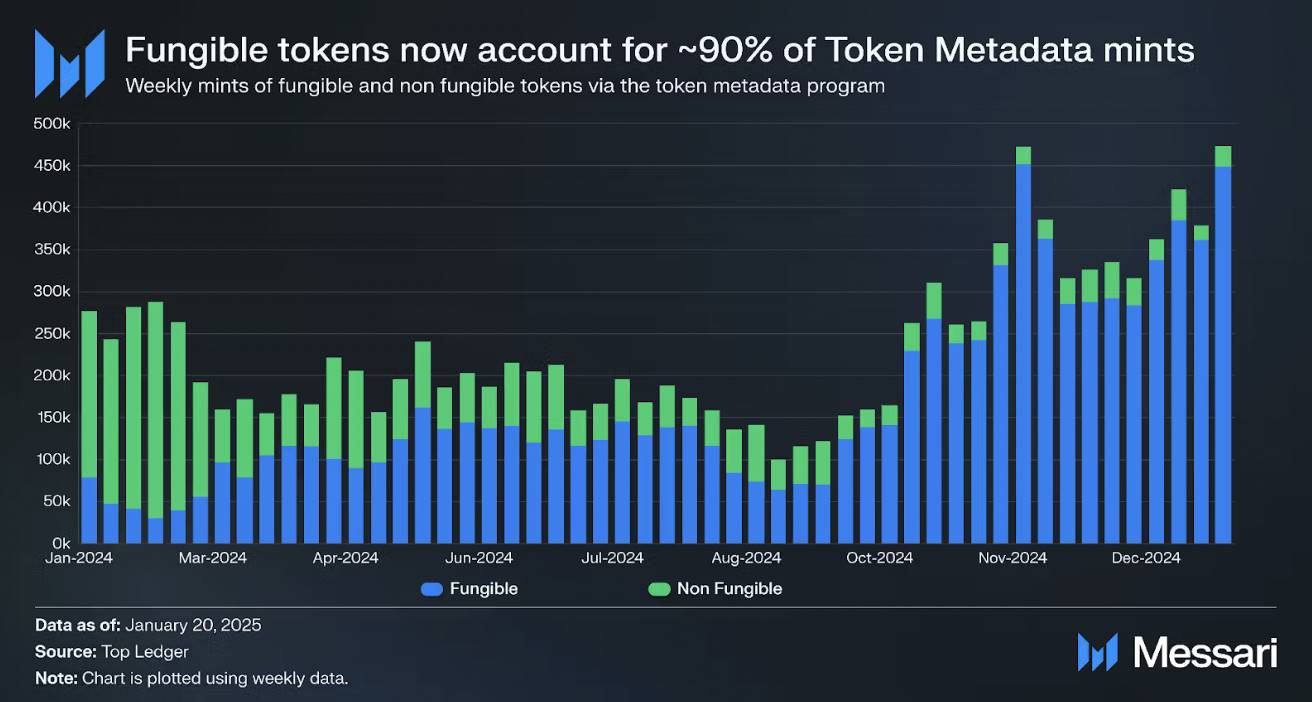
In March 2024, fungible tokens surpassed non-fungible tokens to become the majority of tokens minted weekly by the Token Metadata program. This trend has continued to strengthen from April 2024 onwards, and in the week of January 20, 2025, over 95% of tokens minted by the Token Metadata program were fungible tokens. The dominance of fungible assets via the Token Metadata program can be attributed to the growth of memecoin and AI activity on Solana, which has led to the creation of additional assets in these categories.
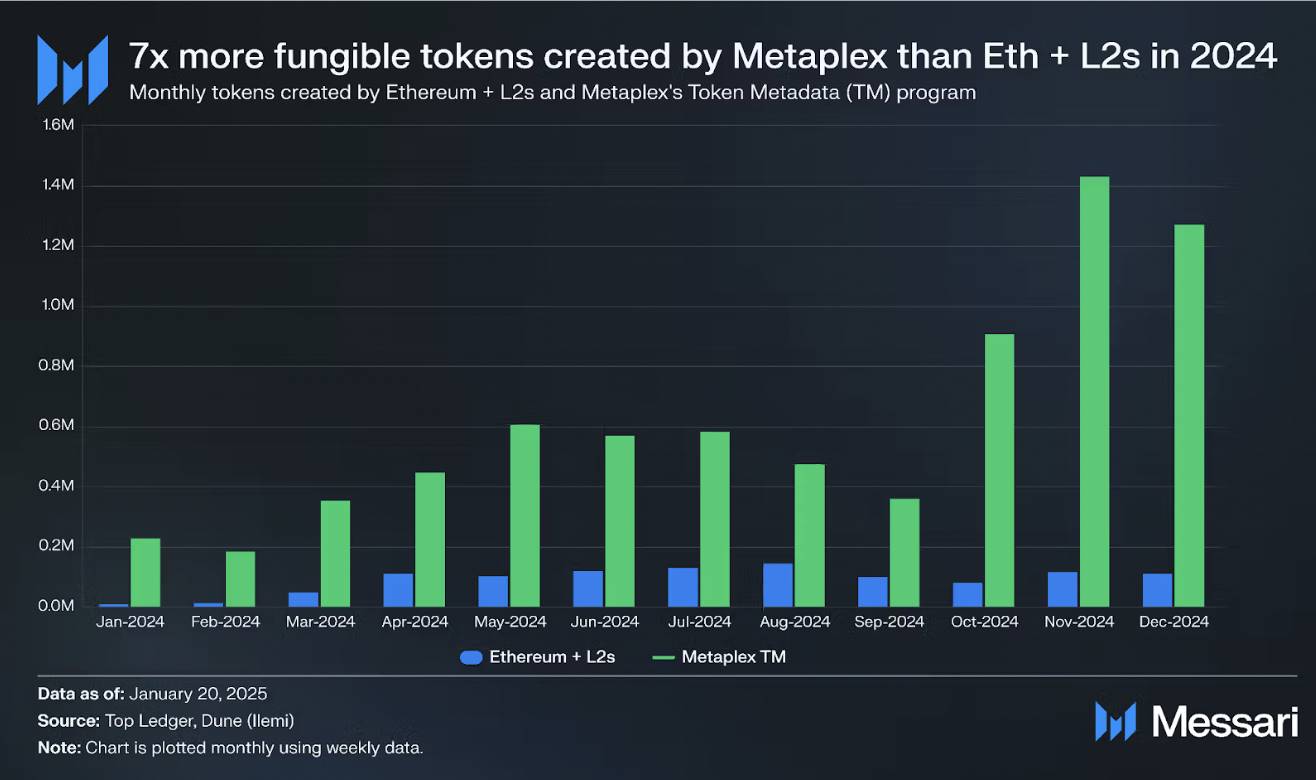
Not only has the number of fungible tokens minted through the Token Metadata program increased by 6x in absolute terms (year-over-year), but it has also reached a relative proportion of ~90% (i.e., the majority of tokens minted by Token Metadata are fungible tokens), and it has also shown a stronger dominance compared to Ethereum and its Layer 2 token minting. In 2024, over 7.4 million fungible tokens were minted through the Token Metadata program, seven times the 1.06 million tokens minted by Ethereum and its Layer 2. Furthermore, in Q4 2024, the number of fungible tokens minted by the Token Metadata program was 12 times that of Ethereum and its Layer 2, showing an upward trend. Ultimately, the dominance of Metaplex’s Token Metadata program in fungible token minting reflects Solana’s dominance in on-chain transaction activity and Metaplex’s position as the authoring protocol for nearly all tokens on the network.
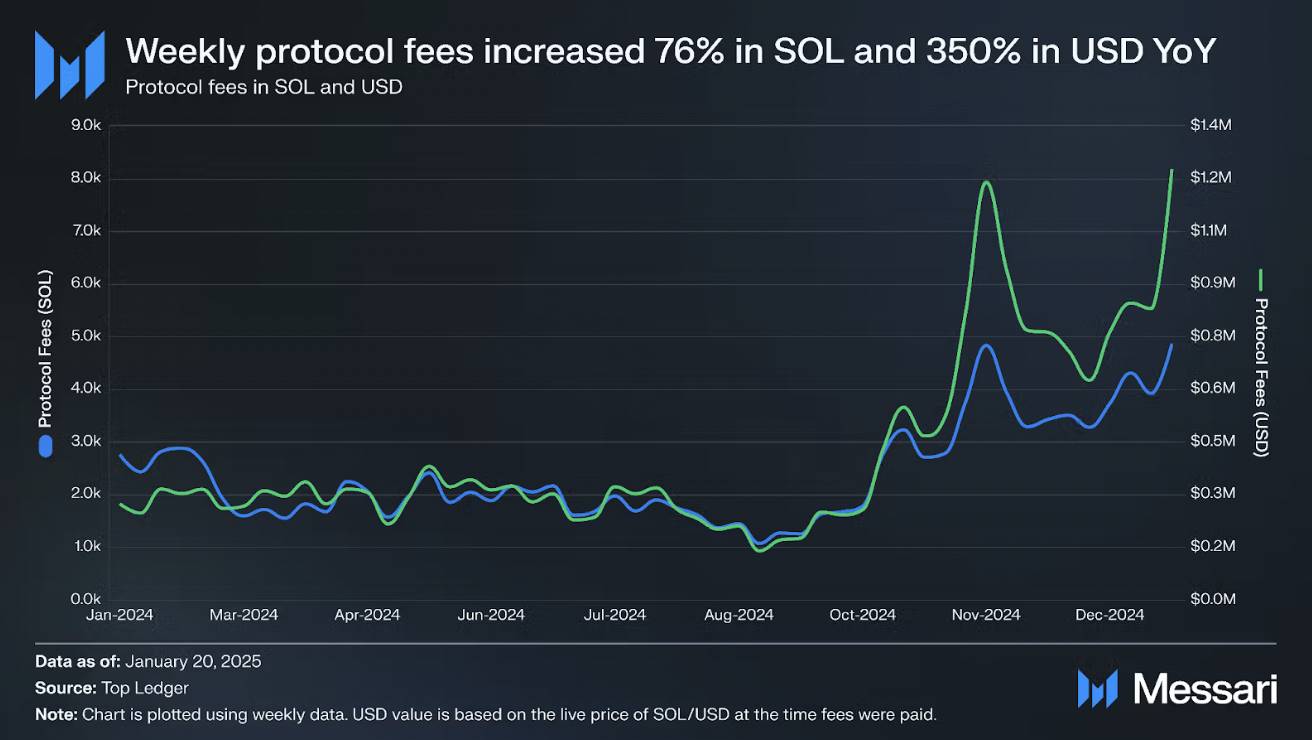
Year-over-year, weekly Metaplex protocol fees increased 76% in SOL terms to nearly 5,000 SOL, and 350% in USD terms to over $1.2 million. While Metaplex’s highest revenue week in December 2023 (11,343 SOL) generated $840,000 in fees at the time, the SOL price rose, leading to a new all-time high of over $1.2 million in fee revenue on January 20, 2025 (4,864 SOL). These outlier weeks are critical to calculating total fees. In comparison, Metaplex’s average weekly fees in 2023 were 1,768 SOL, but the median was 895 SOL, while in 2024 its average weekly fees were 2,306 SOL and the median was 2,050 SOL. The median weekly cost in 2024 is a 130% increase from 2023, while the average weekly cost is only a 30% increase from 2023.
Half of all Metaplex protocol fees are used to buy back MPLX and subsequently contribute to the Metaplex DAO Treasury. This is in stark contrast to many other protocols, which need to pay most of their fees to third parties such as liquidity providers, lenders, or validators, and therefore cannot afford to spend such a high percentage of their fees on token buybacks.
From June to October 2024, Metaplex used 10,000 SOL in fees per month for MPLX buybacks, and 12,000 SOL in November, December 2024, and January 2025. To date, this has resulted in the buyback of approximately 44.47 million MPLX (approximately 4.45% of the total supply), of which approximately 9.2 million MPLX (0.92%) were bought back in January 2025, the largest monthly buyback to date.
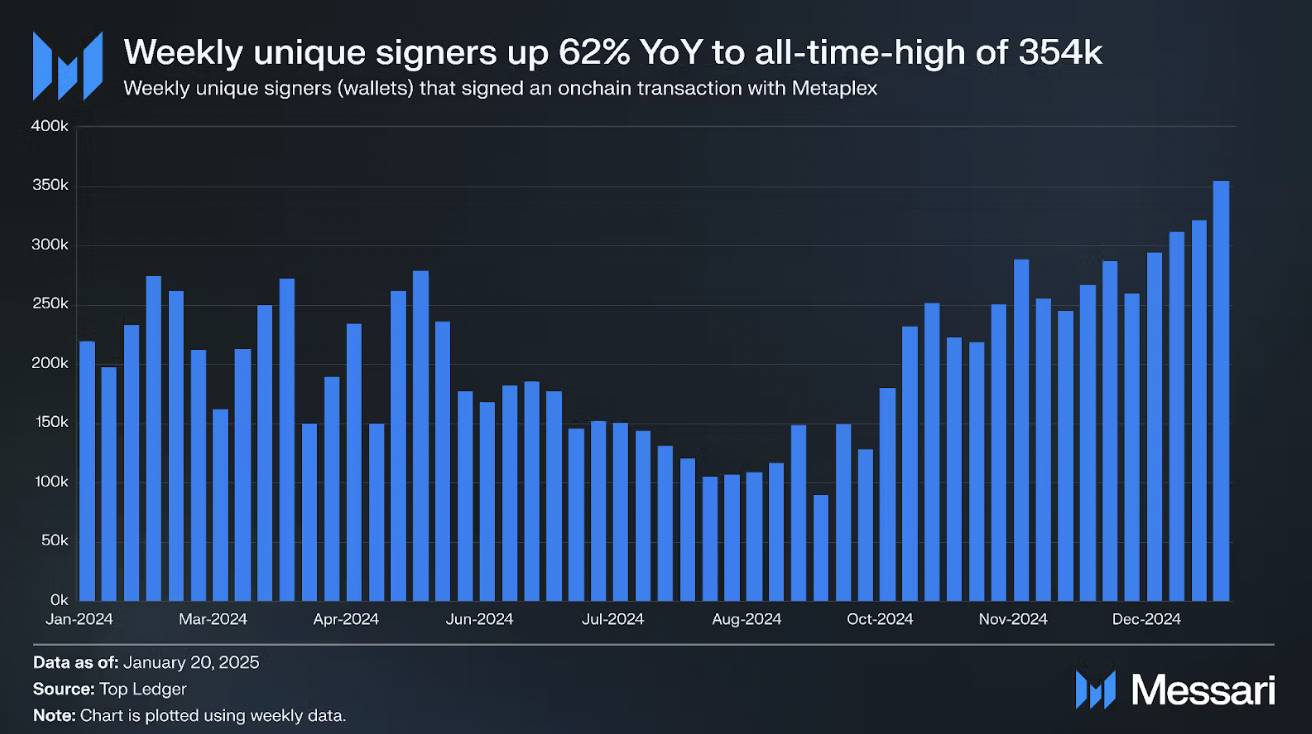
Weekly unique signatories (wallets signing on-chain transactions through Metaplex) increased 62% year-over-year, from 219,000 to a record 354,000. Additionally, Metaplex averaged 196,000 unique signatories in 2024, up 160% from an average of 76,000 in 2023. As with other metrics, much of this growth can be attributed to increased memecoin activity. Another contributing factor is the increase in Core minting, as each Core mint requires a signing wallet. Since August 2024, the monthly number of Core mints has increased from 57,000 to over 400,000 in December.
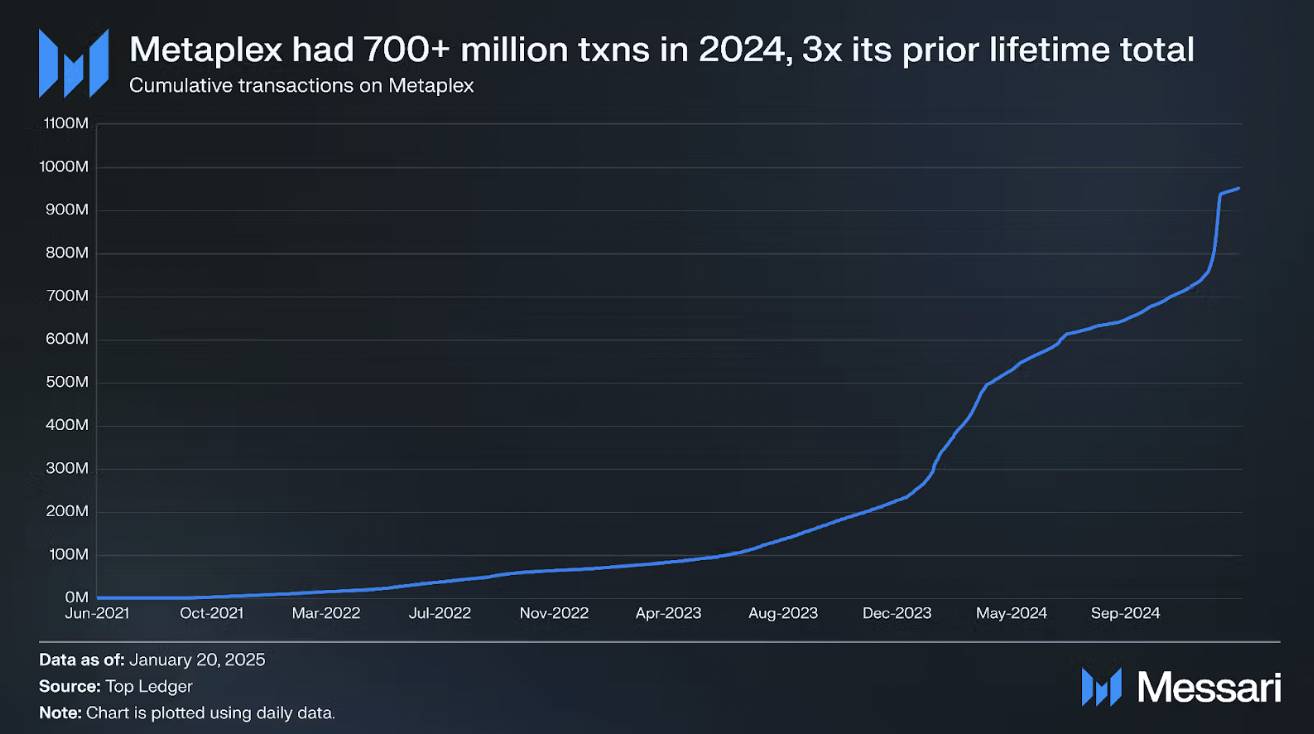
In 2024, Metaplex saw a total of over 705 million transactions, more than three times the previous high of 233 million transactions since June 2021. Additionally, on December 23, 2024, Metaplex hit a new daily record of over 23 million transactions, the sixth consecutive day of record highs following the previous all-time high on February 3, 2024. This surge in transaction volume was almost entirely driven by Bubblegum, which saw over 103 million transactions in the week of December 23, 2024.
Ecology
Metaplex is a key infrastructure protocol for building digital asset applications on Solana and SVM, and is used by almost all projects, including marketplaces, on-chain communities, collectibles platforms, games, RWA projects, DePIN, wallets, RPC providers, blockchain browsers, etc.
Metaplex has driven $9.2 billion in economic activity on Solana, involving 980 million transactions. In addition, Metaplex accounts for more than 99% of NFT minting and more than 90% of fungible token minting on Solana.
As SVMs gain popularity, Metaplex is poised to expand its position as a critical infrastructure layer supporting these new networks. SVM L2s like Eclipse, SonicSVM, and SOON (Solana Optimistic Network) have already integrated the Metaplex Protocol, enabling developers and creators to interact with digital assets on these networks.
Fungible Tokens
Metaplex’s Token Metadata program powers the memecoin economy on Solana. While the protocol is primarily known for NFTs, Token Metadata also manages metadata for fungible tokens, ensuring their interoperability across different applications. The popularity of memecoins on Solana has led to an increase in the use of Token Metadata, with platforms like pump.fun leveraging it to mint new memecoins. Over 11 million fungible tokens have been launched on Solana through Token Metadata, which accounts for approximately 90% of all fungible token minting on Solana in the most recent quarter. Recent notable token launches include President Trump’s official memecoin and Magic Eden’s ME token.
Profile Picture (PFP) NFT
Almost all of the famous NFT collectibles on Solana, including well-known PFP communities such as Mad Lads, DeGods, and Solana Monkey Business, were created using Metaplex. Many of these projects utilize the Token Metadata program, and the recent adoption of Core has resulted in over 2 million Core assets being minted on Solana. Core's features, such as lower minting costs, enforceable royalties, and plugin libraries, have driven its adoption in dynamic asset design.
Digital Collectibles
Platforms such as DRiP and dReader are leveraging Metaplex to innovate in the digital art, music, and comics space. DRiP uses Metaplex’s compressed NFTs (cNFTs) for scalable asset distribution, while dReader brings comics on-chain, providing users with a new way to discover, read, and collect digital comics.
market
NFT marketplaces such as Magic Eden, Tensor, and SolSniper use Metaplex's infrastructure to handle the creation, listing, and trading of NFTs. These platforms rely on Metaplex's Token Metadata, Core, and Bubblegum programs to securely store NFT metadata and facilitate seamless trading of digital art, collectibles, and gaming items. Metaplex solidifies its role in the NFT marketplace by enabling developers and creators to launch native minting and support a secondary trading economy.
Artificial Intelligence (AI)
Artificial intelligence agents have become an important trend in the crypto space, and Metaplex supports automated experiences such as asset minting through its library. Platforms such as SendAI and Griffain use Metaplex’s tools to create autonomous workflows, from asset minting to collection management and marketplace sales.
game
Metaplex supports game developers on Solana, helping to create and manage digital assets such as characters, items, and in-game collectibles. Games like Star Atlas and Aurory use Metaplex’s Bubblegum program to mint compressed NFTs, reducing the costs associated with large-scale collections. Developers also use Token Metadata to create fungible tokens required for in-game economies and Core to create dynamic NFTs with external data integration.
RWAs
Metaplex facilitates the tokenization of real-world assets such as art, real estate, and luxury goods on Solana. Projects like Baxus use Metaplex to tokenize spirit bottles, providing verifiable authenticity and ownership records. Similarly, SkyTrade uses Metaplex to tokenize air rights, connecting RWAs with DePIN.
DePIN
Metaplex is a key component of the growing DePIN space on Solana, helping developers tokenize physical infrastructure. One of the leading projects in this space is Helium Mobile, which is transforming mobile networks by creating a community-owned, decentralized wireless phone network. Helium Mobile uses Metaplex’s Bubblegum program to mint cNFTs, on-chain tokens that represent their physical infrastructure, including hotspot devices that provide service for mobile coverage. Solana is quickly becoming the chain of choice for DePIN projects, with other projects such as Hivemapper, Render, and DAWN also choosing Solana.
wallet
All major Solana wallets, including Phantom, Solflare, and Backpack, support viewing, receiving, and sending Metaplex digital assets. Notably, in December, Backpack integrated the Core Attribute Plugin upgrade, allowing users to view the attributes of on-chain assets directly in the Backpack wallet. This integration is crucial to improving the on-chain gaming experience because it allows players to view important asset characteristics such as level, health, and strength directly in the wallet.
RPC Provider
RPC (Remote Procedure Call) is the communication interface between applications and blockchains, using the Metaplex DAS API to query blockchain data, index transactions and metadata, and provide this data to their clients. RPCs that provide DAS support include Extrnode, Helius, Hello Moon, QuickNode, Shyft, and Triton.
Blockchain Explorer
Blockchain explorers allow users and developers to track transactions, view wallet balances, and access on-chain data. These explorers use the Metaplex DAS API to fetch and present data on Metaplex-enabled digital assets.
Summarize
Metaplex has developed almost all of the important digital asset innovations on Solana, including compressed NFTs, on-chain copyright protection, and Aura (the first data layer optimized for digital assets). In addition, Metaplex's integration with major Solana-based applications such as Phantom, Magic Eden, Tensor, Pump.fun, and collaboration with emerging applications have further promoted the adoption and functional expansion of digital assets throughout the network ecosystem.
With metrics such as minting, unique signers, transactions, and protocol fees hitting new daily, weekly, and monthly all-time highs, Metaplex is poised to continue to be the dominant digital asset protocol on Solana and gain further adoption from the emerging Solana Virtual Machine (SVM) network. New features and innovations like Aura will continue to be added to help the protocol maintain and even expand its dominance in digital asset issuance and management on Solana and the SVM, while launching new services such as indexing and data availability.







